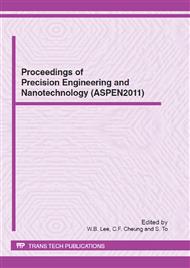p.367
p.373
p.378
p.384
p.390
p.396
p.402
p.408
p.414
Analysis of Tangential Position Error or Removal Function Error in Ultrasonic-Magnetorheological Combined Finishing
Abstract:
Ultrasonic-magnetorheological combined finishing (UMCF) is a new technique for the ultra precision machining of aspheric surfaces, especially for high quality work pieces with small curvature radius concave surfaces. The goal with UMCF is to minimize surface figure errors by optimizing the dwell time and tool path, and the current approach typically results in low amplitude form errors. However, discrepancies exist between the predicted and observed form errors. The major sources of such errors are machine axes positioning errors and unpredicted variations of the removal function. Errors that can produce discrepancies between actual and predicted removal profiles were modelled. A diagnostic method was developed to determine the residual error induced by two types of error. Their effects were examined with numerical simulations and the simulation result was presented. Finally, UMCF experiments are performed on a variety of optical surfaces. The final residual error after polishing is less than 2.6 nm PV values. The successful figuring results prove the validity and advantages of UMCF.
Info:
Periodical:
Pages:
390-395
Citation:
Online since:
June 2012
Authors:
Price:
Сopyright:
© 2012 Trans Tech Publications Ltd. All Rights Reserved
Share:
Citation:


